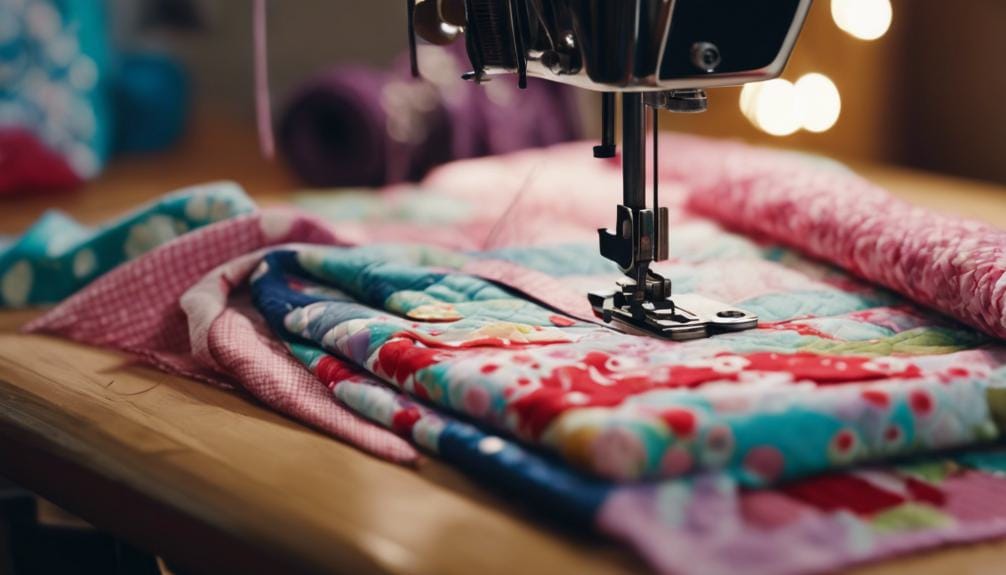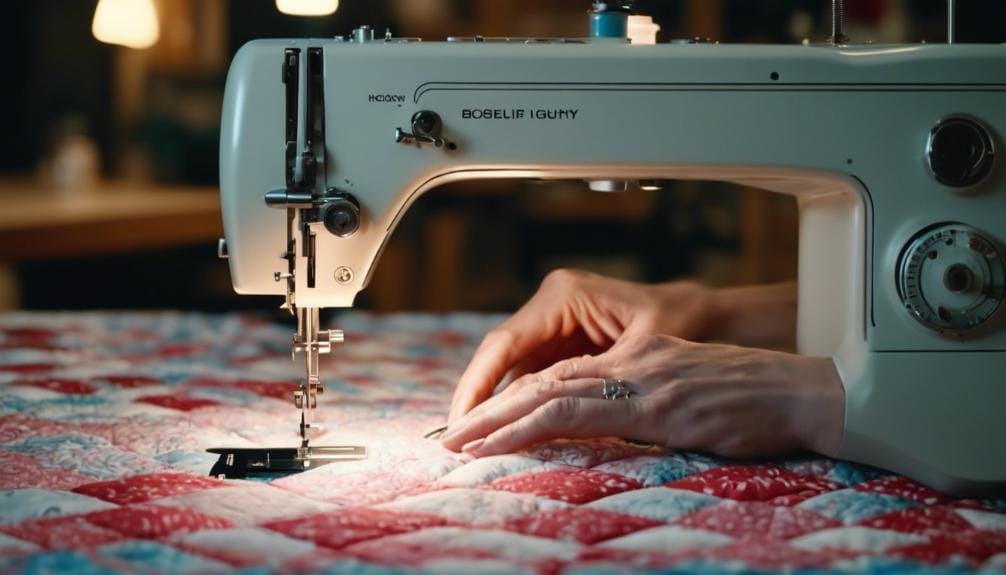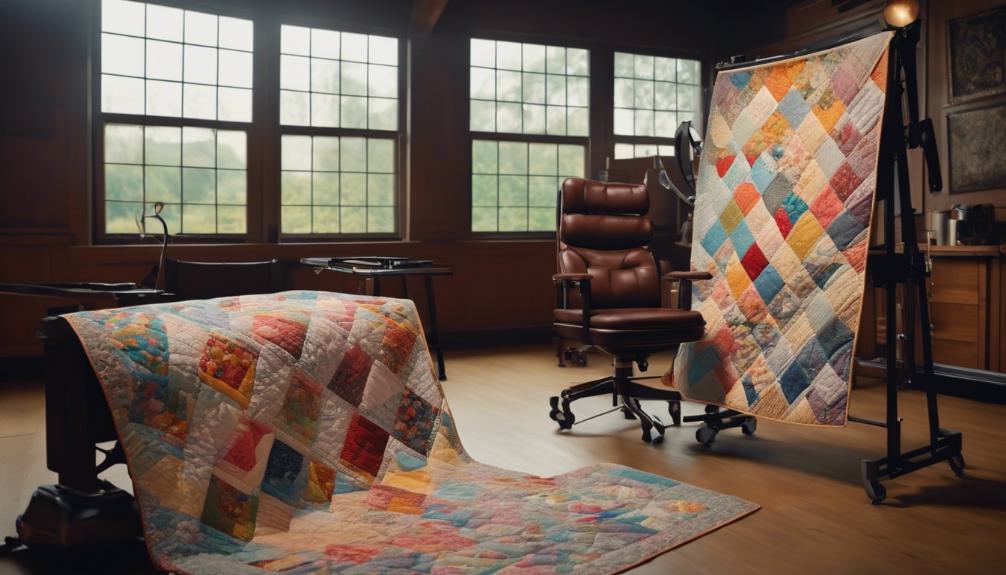How to Quilt Without a Long Arm: Techniques, Tips, and Tools
You might have thought quilting without a long arm machine was daunting, but fear not, as mastering this craft is within your reach.
By understanding essential techniques and utilizing the right tools, you can create beautiful quilts even without a long arm setup.
Stay tuned to uncover the secrets that will transform your quilting experience and elevate your skills to new heights.
Key Takeaways
- Opt for Aurifil 50wt thread and size 11 or 14 needles
- Use quilting gloves and high-quality lighting for better visibility
- Explore walking foot and free motion quilting techniques
- Prioritize comfort with proper ergonomics and breaks
Essential Supplies for Quilting Without a Long Arm
Wondering what essential supplies you need for quilting without a long arm? Let’s dive into the must-haves to make your quilting experience smooth and enjoyable.
When quilting on a regular sewing machine, there are a few key items that can greatly enhance your process. First and foremost, consider using Aurifil thread, typically in 50wt, and opt for size 11 or 14 needles suitable for your machine. These choices can make a significant difference in the quality of your stitches and overall outcome of your quilt.
To aid in maneuvering the fabric smoothly, quilting gloves are highly recommended. These grippy gloves help you maintain control and precision while guiding the quilt through the machine. Additionally, investing in high-quality lighting is crucial to ensure you can see clearly as you work on your project. Proper lighting can prevent eye strain and help you catch any mistakes early on in the process.
For free motion quilting, dropping the feed dogs on your sewing machine is an option to consider. This allows you to move the quilt sandwich in any direction without the interference of the machine trying to feed it forward. Moreover, using a walking foot attachment can help with straight-line quilting, ensuring that the layers of your quilt stay aligned throughout the process. Remember to secure your machine in a stable position to prevent any unwanted movement while quilting without a long arm.
Setting Up Your Sewing Machine for Quilting

Prepare your sewing machine for quilting by adjusting the settings to optimize your quilting experience. Start by ensuring you have the right tools for the job. Choose a darning or free motion quilting foot for more control and flexibility on your domestic sewing machine. Set your needle size to either 11 or 14, depending on the thickness of your fabric, and opt for a 50wt thread like Aurifil for smooth quilting stitches.
To enhance your quilting workspace, invest in high-quality lighting to clearly see your stitching lines. Grippy gloves can also improve your grip on the fabric, making quilting easier and more precise. When you’re ready to start quilting, consider lowering the feed dogs to allow for free motion quilting. Alternatively, attach a walking foot for straight-line quilting to ensure even stitches and prevent fabric shifting.
Stabilize your sewing machine to minimize vibrations during quilting. This will help you achieve neat and consistent stitches without the need for a long arm machine. By setting up your sewing machine correctly and using the right accessories, you can quilt like a pro without the extra expense of a long arm setup.
Techniques for Quilting Without a Long Arm

For quilting without a long arm machine, consider utilizing a regular sewing machine equipped with a walking foot for straight-line stitching precision. This attachment helps feed multiple layers of fabric evenly, ensuring smooth and accurate stitching. When starting with machine quilting, begin by practicing straight-line quilting on smaller projects to gain confidence before tackling larger quilts.
As you progress, explore free motion quilting techniques to add creative designs to your quilts. Free motion quilting involves dropping the feed dogs on your sewing machine and moving the fabric freely under the needle. Secure your quilt layers using basting methods like pin basting or spray basting to prevent shifting while quilting. When working on larger quilts, focus on quilting small sections at a time and frequently repositioning the quilt to fit under the machine.
To maintain your quilting momentum, pay attention to your body posture and take breaks when needed. Proper ergonomics and body care are essential when quilting for extended periods without a long arm machine. Remember to stretch your muscles, stay hydrated, and listen to your body to avoid discomfort or strain. By incorporating these techniques and caring for your body, you can successfully quilt without a long arm machine while creating beautiful and intricate designs.
Tips for Comfort and Ergonomics

To enhance your quilting experience and prioritize your physical well-being, consider making adjustments to your workspace setup and incorporating ergonomic tools for optimal comfort. Here are some tips to ensure you stay comfortable while quilting without a long arm machine:
- Adjust Your Chair Height: Set your chair at the right height to maintain proper posture. This helps prevent strain on your back and shoulders as you work on your large quilt for extended periods.
- Use Grippy Gloves: Invest in grippy gloves to improve your ability to grip the fabric and reduce hand fatigue during long quilting sessions on your domestic machine. This enhances control and comfort while working on intricate details of your quilt top.
- Maintain a 90-Degree Arm Angle: Keep your arms at a 90-degree angle to minimize strain and discomfort while quilting. This position promotes better blood circulation and reduces the risk of muscle fatigue, especially during free-motion quilting.
Exploring Different Quilting Designs and Tools

Explore a variety of quilting designs and tools to expand your creative possibilities and enhance your quilting projects. When quilting without a long arm, you can experiment with intricate designs such as pebbles, swirls, waves, and feathers using a regular sewing machine. To achieve professional results, consider utilizing quilting tools like thread stands, top stitch needles, quilting gloves, and spray baste. As you progress, gradually upgrade your tools based on your confidence levels and experience to enhance your quilting outcomes.
To help you visualize the importance of quilting designs and tools, refer to the table below showcasing some essential items and techniques:
| Quilting Tools | Description | Purpose |
|---|---|---|
| Thread Stands | Holds multiple spools of thread for easy access | Ensure smooth thread flow |
| Top Stitch Needles | Strong needles for quilting through layers | Prevent needle breakage |
| Quilting Gloves | Provide grip and control while quilting | Enhance maneuverability |
Remember to practice different designs on scrap fabric to refine your quilting skills and gain confidence. Embrace imperfections as part of the learning process and focus on mastering diverse quilting designs on a regular sewing machine. By incorporating various quilting designs and tools into your projects, you can achieve stunning results reminiscent of a Missouri Star Quilt.
Frequently Asked Questions
Do You Need a Long Arm to Quilt?
You don’t need a long arm to quilt. With a regular sewing machine and proper techniques, you can achieve professional results. Quilting on a domestic machine offers flexibility, cost-effectiveness, and creative control. Practice and the right tools make it rewarding.
What Is the Alternative to a Long Arm Quilting Machine?
To quilt without a long arm, you can utilize a standard sewing machine. With proper techniques and practice, you can achieve intricate quilting designs. Save money and enjoy the flexibility of quilting at home with personalized finishes.
What Is Free Arm Quilting?
Free arm quilting allows you to stitch intricate designs on a standard sewing machine. Maneuver fabric easily in tight spots and around curves. Perfect for detailed stitching on small projects. Versatile for quilting cuffs and collars.
Can You Quilt With a Normal Sewing Machine?
Yes, you can quilt with a normal sewing machine. It’s cost-effective and offers flexibility for quilting any size. Techniques like free motion quilting and walking foot quilting are possible. Save money and personalize quilting at home with practice and the right tools.
Conclusion
Now that you have all the essential supplies, techniques, and tips for quilting without a long arm machine, you’re ready to embark on your quilting journey with confidence and creativity.
Remember to take care of your body, set up your sewing machine properly, and experiment with different quilting designs to make your quilts truly unique.
With practice and perseverance, you can enjoy the art of quilting and create beautiful pieces to cherish for years to come.
Happy quilting!
